| When I first was learning about plants decades ago, "juniper" conjured over-planted, drought-tolerant, prickly shrubs of potent odor, making hard bluish berries rather than cones. It was pleasing to discover that some junipers grew into admirably lofty trees; some lived thousands of years; some even required summer moisture to thrive. |
| My city, Seattle, lacks a native juniper. But not far north and west of the city, on and near Whidbey Island, Everett, and through the San Juan islands to Vancouver Island, are native junipers. This population --as of December 2007-- was renamed Juniperus maritima --a split-off from the main population of Rocky Mountain Juniper, Juniperus scopulorum. The split-off population is called the Seaside or Puget Sound Juniper. |
| Though the name change was late in coming, as early as 1969 the eminent Pacific Northwest botanist C. Leo Hitchcock wrote: "Plants from the islands of Puget Sound appear to differ somewhat from those east of the Cascades in having the juvenile foliage longer-persistent and in producing cones [berries] that are less fleshy and rather consistently 1-seeded and it is believed not improbable that they will prove to constitute a distinctive race of the species." |
| Typical Rocky Mountain Juniper is essentially a mere western North American extension of Juniperus virginiana. These two species intergrade and properly can be viewed as subspecies. Doubtless they originated from a common ancestor. In 1876 George Vasey called the Rocky Mountain Juniper Juniperus virginiana var. montana. It was not until 1897 that Charles Sargent specified it as Juniperus scopulorum. |
| Both Juniperus virginiana and Juniperus scopulorum are highly variable in appearance, rapid growing, indifferent to soil conditions, and even relatively weedy. The Rocky Mountain Juniper has been credited with having birthed over 75 named cultivars! They vary much in color, shape, foliage and growth rate. Some of their variation is expressed in names such as 'Big Blue', 'Blue Pillar', 'Emerald Green', 'Gray Gleam', 'Hill Weeping', 'Montana Green', 'Moonglow', 'Platinum', 'Silver Beauty', 'Skyrocket', 'Steel Blue', 'Stikine Spire', 'Tabletop', and 'Wichita Blue'. |
| To distinguish Rocky Mountain Juniper from Juniperus virginiana, note that the foliage of the former is coarser and more strongly aromatic. If the plant is a female and has berries, those of Juniperus virginiana are smaller, usually single-seeded, and ripen after only one year. |
| The Puget Sound Juniper's appearance is insufficient to justify making it a separate species. However, its genetics and its behavior make a compelling case for nominal distinction --whether subspecies or species. It is, compared to Rocky Mountain Juniper and Juniperus virginiana: notably not variable; not fast-growing; not at all weedy; not thriving except in alkaline or calcium-rich soils. Moreover, while Rocky Mountain Juniper and Juniperus virginiana are both valuable as ornamental trees and shrubs, the Puget Sound Juniper is hampered therein by its plain unvarying appearance (heavy green color, squat dumpy form), slow growth, and fussiness as to soil. |
| Recently I examined 10 specimens of what were known definitely --or thought very likely-- to be Puget Sound Juniper specimens planted in Seattle's Washington Park Arboretum. The tallest measured 30.5 feet (#45-54B in grid 34-4W). The healthiest, most handsome, was also the oldest: #1034-50 in grid 2S-5E, 25.5 feet tall; female (photo below). It had been a gift to the arboretum in June 1950, by the avid Seattle gardener Frances K. Roberson. Though, unlike the other 9 specimens that were documented as having been obtained from the wild, Roberson's gift tree had an undocumented origin. Nonetheless, inasmuch as Roberson grew and sold many Washington native species, and since the tree looked like the other specimens of known provenance, I infer it was. It grew with two other specimens of known provenance in the arboretum rockery, where the soil was less acidic than that under the other specimens in the arboretum. These three rockery trees were cut down April 23rd in the renovation of the rockery. |
Most of the arboretum's other Puget Sound Junipers are so unhealthy that they bear overmuch juvenile foliage, are thin rather than dense, and are notably ugly. Since the arboretum has locations (in the pinetum and conifer meadow) where two specimens of the same accession grow side by side, it would be an interesting experiment to apply ground limestone around one of the trees in each pair, and observe the difference in the next several years. I predict the limed trees would gradually become healthier and look better.
|
| #45-54A in grid 34-4W (in pinetum; south) |
#45-5454B in grid 34-4W (in pinetum; north)
|
| #45-54C in grid 42-6W (in conifer meadow; west) |
#45-54D in grid 42-6W (in conifer meadow; east)
|
| In the wild, some Puget Sound Junipers are estimated at as many as 400+ years of age. In contrast, a Rocky Mountain Juniper called the Jardine Juniper, in Cache National Forest, Utah, is estimated over 3,000 years old. That tree in 1989 measured 40 feet tall, its stout trunk 20 feet 7 inches in circumference. In 2006 the trunk was measured at 23 feet 8 inches; it is mostly dead. |
| As for the Puget Sound Juniper's maximum size, one at Sidney, B.C., measured 48 feet tall, its trunk 14 feet 5 inches in circumference (1989); another at Deep Cove, B.C., stood 78 feet tall, its trunk 9 feet 5 inches in circumference (1972). |
According to a herbarium label at the U.W., in 1889 the Puget Sound Juniper was being cultivated in Seattle --possibly by native Americans. But it is still very rarely seen cultivated here. If you desire to buy a Puget Sound Juniper for your garden, MsK Nursery in Shoreline, has some seedlings (http://www.msknursery.com/). In April I bought one (for $12), and planted it in a part of my garden near beets and chenopods where I heavily limed the soil. You can see it if you visit my Open Garden in June. It is presently 11 inches tall and 9 inches wide.
|
To read scientific journal articles (found online as PDFs) about this species and its terpenoids, ITS sequences and much more, see:
|
1) Phytologia 89 (3) December 2007, pages 263 to 283: Juniperus maritima, the Seaside Juniper, a new species from Puget Sound, North America.
|
2) Phytologia 92 (1) April 2010, pages 68 to 81: Discovery and SNPS analyses of populations of Juniperus maritima in the Olympic Peninsula, a Pleistocene Refugium?
|
The second article discusses junipers found in the NE Olympic Mountains (such as at Deer Park), and concludes they are the "original" J. maritima:
|
"With the discovery of J. maritima at high elevation sites, it does seem possible that J. maritima survived the Pleistocene in the Olympic Peninsula. It may be that before the Pleistocene, J. maritima was a montane species and that it merely spread to open habitat on rocky seashores in the Strait of Georgia and Puget Sound during the Hypsithermal (10,000 - 6,000 years before present). The DNA data presented in this study did not show much differentiation between the seaside populations and the montane populations of the Olympic mountains. Additional analyses of more sensitive markers may reveal differentiation, but at present it appears that the seaside populations of J. maritima are of very recent origin with little difference from the montane (ancestral) populations."
Back |
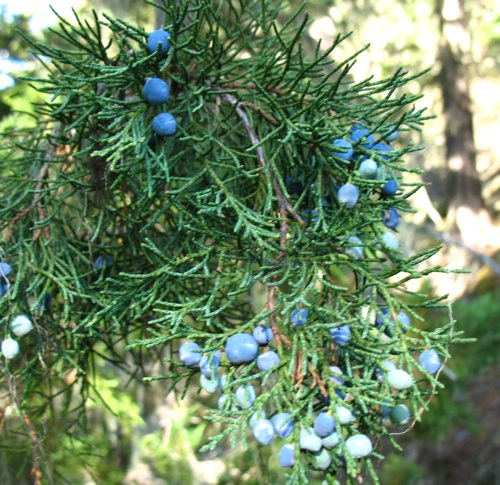
Juniperus maritima berries; Oct. 2009 photo by Ian Barclay
|
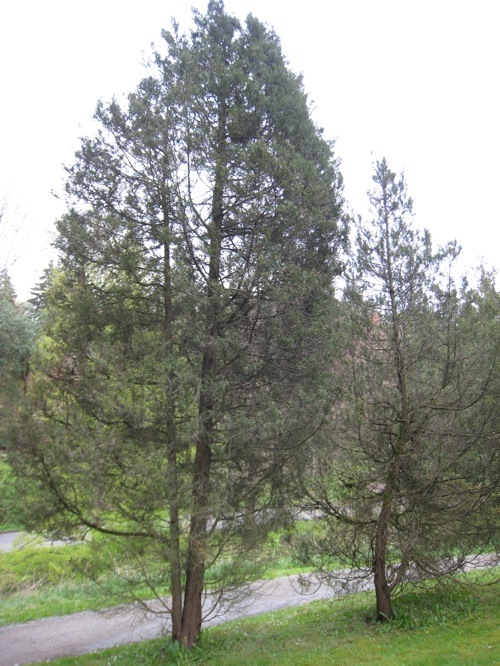
Juniperus maritima pair in WPA pinetum; April 2010 photo by ALJ
|
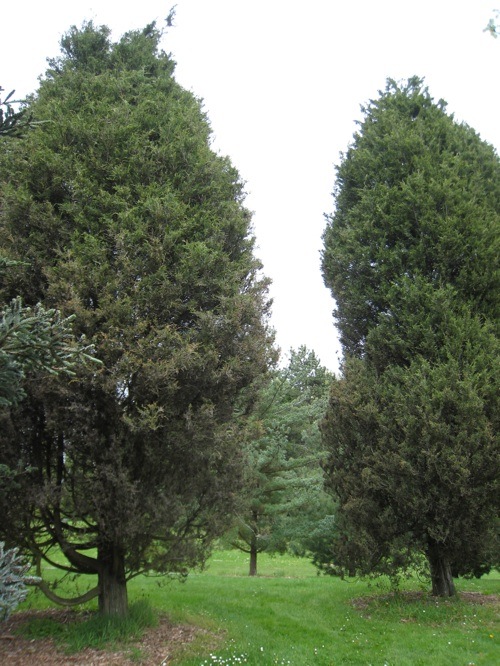
Juniperus maritima pair in WPA conifer meadow; April 2010 photo by ALJ
|
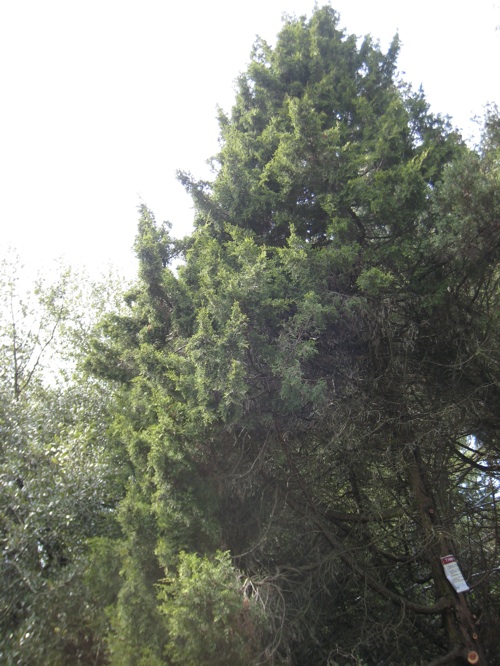
Juniperus maritima in WPA rockery; April 2010 photo by ALJ
|
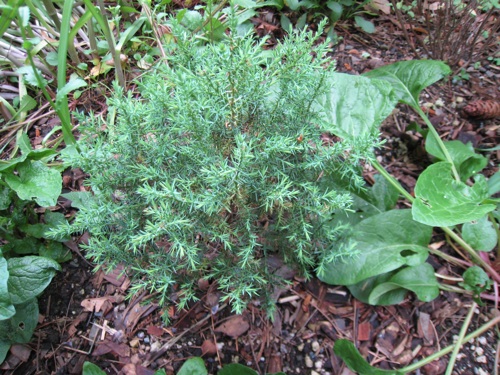
Juniperus maritima seedling in ALJ garden; May 2010 photo by ALJ
|

